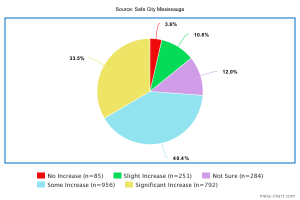For the most part, average people are exposed to crime prevention learning when they take a retrospective look at the actions that led up to their becoming the victims of criminal events. Even then, the prospect for meaningful crime prevention learning is very limited in the absence of professional advice or guidance, given that most people’s do-it-yourself form of crime prevention typically results in a band-aid response and is seldom forward-thinking.
In circumstances where the victim seeks or is offered professional advice, his or her prospects of being a repeat victim can be dramatically reduced if the advice from professionals such as the police or insurance industry is heeded. Unfortunately, even the advice from these entities, if and when it’s forthcoming, is once again generally restricted to the circumstance at hand, which does little if anything to prepare the victim for his or her next encounter with crime, should it occur.
The news is not much better for anyone who finds themselves in the much more favourable position of being exposed to crime prevention advice without first being a victim. In these circumstances, the potential victim is generally afforded crime prevention information on an a-la-carte basis, which may take a variety of topic-specific formats, such as pamphlets, fact sheets, presentations, give-aways, or public service messages. The net result is a general public which remains susceptible to a basket of garden-variety crimes and a significant criminal victimization rate that far exceeds the capabilities of any police service delivery model.
The only real method for overcoming these obstacles is establishing programs that provide for crime prevention learning. Meaningful crime prevention learning can lead to the development of crime resilient communities by developing community members’ crime prevention capacity. Progressive police services have discovered that the only sure route to crime prevention learning is through a Crime Prevention Academy.
Crime Prevention Academy
A Crime Prevention Academy offers community members the opportunity to take a comprehensive, police-led crime prevention program that is capable of rallying and motivating people. It accomplishes this by providing its participants with practical “need to know” knowledge that is directed at keeping them, their loved ones, and their property safe and secure. In the process, these academies fill a huge gap in the delivery of meaningful crime prevention information that, as in the case of the Peel Regional Police Service in Ontario, meets a need first identified by the community through a Survey of Attitudes and Opinions conducted by that agency as part of an ongoing community consultation process.1
The importance of the information gleaned from that survey cannot be understated. It first and foremost served to advance the idea that there was a significant appetite for the development of additional crime prevention programs provided that they were of interest to the public and the resources offered represented “real value.”2 It further supported the idea to position and promote the course as the crime prevention equivalent of the St. John Ambulance First Aid course, a long-established and widely respected program known for the delivery of comprehensive first aid training to the general public.
How the Program Works
A Crime Prevention Academy provides real crime prevention learning by providing its participants with a basic understanding and appreciation of what crime prevention is, followed by the development of a working knowledge of how best to assess and then address the most common forms of crimes. A Crime Prevention Academy follows the citizen police academy model by requiring its participants to attend a class once per week for a total of 10 to 15 hours of training, depending upon the program design and type.
Examples of the longer version of this program (15 hours) have included a six-week version first developed by Peel Regional Police, followed by Safe City Mississauga’s award-winning Crossroads Youth Academy in Ontario, and the five-week Guardian Academy developed by the Chandler Police Department in Arizona.3 The Guardian Academy recently drew the attention of the IACP at their 2018 Leadership Awards at IACP 2018 in Orlando, Florida, where Chief Sean Duggan and Retired Police Officer Tina Balsewicz were presented with the IACP/ecoATM Leadership in Crime Prevention Award.
The aim of the Guardian Academy is to educate all caregivers with the needed information that they require to help them “understand, cope with, and prevent criminal activities of minors; ultimately leading to the reduction of criminal activity as the minor ages into adulthood.”4 It accomplishes this by targeting any responsible person put in the care, control, custody, and guardianship of a child such as parents, guardians, grandparents, coaches, teachers, and others and teaching them about social media, societal trends, and risky and criminal activity such as human trafficking, drug trends, and gangs. They are further provided with follow-up support in the form of an innovative, closed Facebook group, which provides graduates of the program with a “safe forum for cross talk” and real-time support.
The thematic approach to the development of Crime Prevention Academies is a testament to the versatility of the concept which has served as the inspiration for specialized versions by Peel Regional Police, which has also included a six-week Neighborhood Watch Academy along with two four-week versions known as the Parents’ Crime Prevention Academy and the very successful and popular Cyber Academy.5
In all the preceding examples, the need for genuine crime prevention learning was not only recognized by crime prevention officers, but it was also facilitated by officers. Dedicated crime prevention officers appreciate that the only way they can be reasonably certain that members of the public will benefit from the timely application of crime prevention knowledge is to provide them with the requisite training and motivation that they need prior to being tested by a criminal event. It is only when the community reaches this level of crime prevention capacity that crime prevention officers can have confidence in the community’s ability to self-protect. Unfortunately, developing crime prevention capacity in a community is not without its challenges, the most obvious of which is the police service’s capability as it relates to the establishment of a graduate base that is tailored toward and promotes participation from high-risk and vulnerable communities.
To accomplish just that, the Peel Regional Police delivered many of its academies in partnership with local community support agencies who, as part of their missions, routinely engaged high-risk and vulnerable populations within the larger community. Among these were Safe City Mississauga, a not-for-profit crime prevention association, that organized the delivery of Crossroad Youth Academies directly to high school students; immigrant services agencies, which provided access to newcomers to Canada as part of their English as a Second Language classes; and community living support agencies, which provided access to groups of developmentally challenged adults as part of their engagement with that community. These partnerships generated a tremendous synergy between the police service, “host” agencies, and the communities they supported. In the case of the partnership between Peel Police, Safe City Mississauga and the local school boards, this resulted in the training of approximately 20,000 students.
As impressive as these results are, perhaps the greatest potential may be through the development of online Crime Prevention Academies such as the Citizen’s Academy offered by the Hertfordshire Police Service in the United Kingdom.6 Their online format is broken down into 11 core modules that provide for crime prevention learning by promising to “keep you and your community safe through developing your knowledge of protection and crime prevention measures.” Each module is preceded by a series of short lectures followed by a 10-question quiz and a downloadable certificate for each successfully completed module that is used to help drive enrollment and support completion.
Outcomes and Results
The Crime Prevention Academy concept is known to produce a broad spectrum of tangible and highly desirable results that can generate a significant amount of real crime prevention learning and meaningful levels of crime prevention capacity that can lead to more crime resilient communities. The process benefits from a multiplier effect when graduates share their knowledge with family, friends, neighbors, colleagues, congregations, and others, such as the time when a Crime Prevention Academy graduate educated her immediate neighbors about the benefits of installing a security strike plate in an effort to bolster the forced entry resistance of the dead bolt lock where it engages the frame of the door. This effort translated into an immediate transfer of knowledge that generated tangible results when all five homes were retrofitted with security strike plates.
| Figure 1: Knowledge Gain Survey Response
To what extent, if any, did the Crossroads presentations increase your knowledge of the following topics (1-no increase to 5-significant increase)
|
Statistical evidence capturing the degree of crime prevention learning has routinely been documented by both Peel Regional Police and Safe City Mississauga, the latter of which produced and publishes an annual report entitled Measuring the Value of Safe City Mississauga’s Crossroads Youth Academy Programming. The report included the results of a survey question on knowledge gain, which can be seen in Figure 1.7
While surveys were a common means of data collection for both organizations, Peel Regional Police quantified the degree of learning by means of a pre- and post-test, the results of which are immediately shared with the participants as part of a large group exercise. The test results typically demonstrate a 19– 25 percent improvement in the test scores from the pre-test to the post-test.
Evidence of the development of crime prevention capacity has also been documented by means of a Lifestyle Survey administered at the end of the Peel Regional Police Academy, as well as from their (then) bi-annual Survey of Attitudes and Opinions.8 Evidence from the Lifestyle Survey shows that 86 percent of graduates stated that they felt much safer as a result of having taken the Crime Prevention Academy. This translated into a significant 10-point drop in the number of respondents who still identified the need for additional crime prevention programs in the Survey of Attitudes and Opinions as one of their three most important programs in post-academy years.
As impressive as these results are, the strongest case for adopting the Crime Prevention Academy approach can be found in the results that speak to crime resiliency. In this regard, the Peel Regional Police focused on two key outcomes for the purpose of demonstrating the degree to which graduates had been motivated to put principles into practice and the overall impact on crime.
The first outcome was measured by the Lifestyle Survey, which found that 86 percent of participants indicated that they had changed their practices as a result of the information they learned while taking the academy. Moreover, 85.5 percent of participants indicated that they had acted on suggestions made during the Crime Prevention Academy. This important outcome speaks volumes with respect to the academy’s ability to motivate, influence, and serve as a crime prevention catalyst where its participants are concerned.
These behavioral changes, in turn, sets the stage for the development of crime resilient communities. In this regard, the Peel Regional Police undertook a follow-up victimization survey administered a year after an identical survey was first undertaken as part of several first-session exercises conducted at the beginning of each academy.
The surveys demonstrated that households with a Crime Prevention Academy graduate enjoyed a very healthy and substantial 66.6 percent drop in their household’s year-over-year victimization rate after taking the academy. This result represents a massive increase in the level of crime prevention resiliency when measured at the household level.
Effect on Community-Police Relations
 While virtually any form of an academy can be expected to generate goodwill, those that are dedicated to teenage audiences offer the greatest potential for positive change. As this change can represent an enormous benefit when dealing with youth-police relations, it is essential that steps are taken to record the magnitude of this shift when dealing with academies that are directed towards a teen demographic.
While virtually any form of an academy can be expected to generate goodwill, those that are dedicated to teenage audiences offer the greatest potential for positive change. As this change can represent an enormous benefit when dealing with youth-police relations, it is essential that steps are taken to record the magnitude of this shift when dealing with academies that are directed towards a teen demographic.
Such has been the case with Safe City Mississauga’s Crossroads Youth Academy, which captured the shift in four key sentiments by means of a survey administered at the beginning and end of the program. The survey asked students to rate police according to their perceptions in the following key areas:
-
-
- Police Are Connected to My Community
- Police Treat People Fairly
- Police Care About My Community
- Police Are Needed to Protect My Community
-
What they found was a 10–20 percent reduction in neutral responses regarding police across all categories with a corresponding 14–25 percent increase in positive agree or strongly agree statements at the end of the academy. This valuable and important shift in sentiment is captured by the following anonymous statements:
“They do things that will benefit and keep us safe. I also don’t think I am scared of them anymore because they are actually pretty good people.”
“Police officers seem like nice people and I feel like if I have problem, I can speak to them about it.”
“After the presentations, I learnt that underneath the badge and bullet proof vest is a normal person with a normal life, just doing their job.”9
It is clear from the foregoing statements, that the equivalent of a seismic shift in sentiment has occurred across a broad range of important statements. The value of this shift is even more important, given that the academy created the opportunity for a prolonged and positive interaction with police to occur during what is a relatively early and influential point in a person’s life, which is often void of positive interactions.
Conclusion
Police services around the globe would do well to recognize that they cannot begin to address the need that currently exists for crime prevention learning without first embarking on the development and delivery of a Crime Prevention Academy–style program that is capable of rallying and motivating people. The Crime Prevention Academy is a proven concept that takes the best features of the citizen’s police academy and transforms it into a laser-focused program directed at keeping people, their families, and their property safe. In the process it helps to provide for crime prevention capacity, which is an essential element in the building of crime resilient communities that Crime Prevention Academies, regardless of the form they may take, continue to grow, one household at a time.
Notes:
1 The Peel Regional Police are located on the outskirts of Toronto, Ontario, and are responsible for policing delivering policing services to over 1.4 million residents of the cities of Brampton and Mississauga.
2 Peel Regional Police, 1999 Survey of Attitudes and Opinions: 46 percent of people “listed additional crime prevention programs as one of the three most important (service-wide) programs”; Brampton Safe City Association survey: 38 percent said that they were “likely to participate in a crime prevention initiative if it is of interest to them, and married families are looking for resources that represent real value.”
3 Safe City Mississauga is a registered charitable organization founded in 1992 to help reduce criminal opportunity and criminal victimization in Mississauga, Ontario.
4 International Society of Crime Prevention Practitioners’ 2005 Program of the Year; Tina D. Balsewicz, Sean Duggan, and Craig Uchida, “Guardians at the Gate,” Police Chief (October 2019).
5 The Neighbourhood Watch Academy was delivered to Neighborhood Watch groups at a local venue located within a Watch area and included participation by family members; the Parents’ Crime Prevention Academy Ceased in 2014; Peel Regional Police, “Courses and Seminars,” 2018.
6 Police and Crime Commissioner for Hertfordshire, Citizen’s Academy.
7 Valerie Briffa, Quick Facts (2017): Measuring the Value of Safe City Mississuaga’s Crossroads Youth Academy Programming (Safe City Mississauga, 2018).
8 The Survey of Attitudes and Opinions is currently administered on an annual basis.
9 Briffa, Quick Facts (2017).




